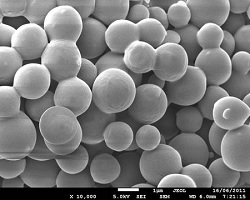 |
| Using alcohol in the drying process produces small, uniform particles.--Courtesy of Monash University |
Australian scientists have found a new way to develop ultrafine particles that make inhalable drug delivery more consistent and efficient for the treatment of lung conditions such as asthma.
The technique, called anti-solvent vapor precipitation, makes use of alcohol to dehydrate the particles, making them smaller and more uniform in size. The resulting particles, created by Monash University researchers, are each smaller than a micron, as opposed to the larger ones created via traditional dehydrating mechanisms, according to the university.
Monash's Meng Wai Woo had been investigating the use of ethanol to produce the ultrafine particles in 2011 while researching a similar process for the dairy industry. To produce lactose crystals, Woo and his team used nitrogen laced with ethanol vapor as an alternative to a hot air drying method. Instead of crystals, the scientists ended up with the miniscule, uniform particles.
"Ultrafine uniform particles will ensure that fewer drug particles get stuck in the throat while more can reach the lower regions of the lungs," Woo said in a statement. "Because we can now make the small particles more uniform, it means the inhalers will work better."
The university noted that infusion devices and metered dose inhalers account for about $20 billion in sales worldwide, and improving both efficiency and cost has been a key concern.
"From a drug manufacturer's perspective, this new approach can maintain the uniformity of the particle and yet potentially maintain a commercially viable production rate," Woo said.
The team is now building a demonstration unit for the process, which the university said will be completed later this year.
- here's the release